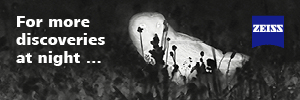- Buteo platypterus
Identification
Length: 34-44 cm (13.5-17.5 in); wingspan: 81-100 cm (31.75-39.25 in); weight: 275-560 g.
The second smallest buteo in North America, the Broad-winged Hawk is a small, stocky hawk with broad black and white tail bands. Primary 6 generally less pronounced, giving a 4 fingered appearance.
There is a rare dark phase morph.
Distribution
Breeds in North America and the Caribbean, winters from southern USA to South America.
In summer, the North American range includes from Southern Canada extending west almost to British Columbia to Florida and Texas.
Migrates in large groups called "kettles" from Northern South America to the Eastern United States. Is often observed in large numbers during migration at "hawk watches" throughout the Eastern U.S and Canada.
Taxonomy
Subspecies

Photo © by Stanley Jones
Brazos Center, Bryan, Brazos County, Texas, USA, April 2022
There are 6 subspecies[1]:
- B. p. platypterus:
- B. p. cubanensis:
- B. p. brunnescens:
- B. p. insulicola:
- B. p. rivierei:
- Lesser Antilles (Dominica, Martinique and St. Lucia)
- B. p. antillarum]]:
- Lesser Antilles (St. Vincent and Grenada) to Tobago
Habitat
Whilst preferring deciduous forests, is also found in rainforests and second growth, river valleys and coastal sage scrub.
Behaviour
Most often hunts from perches taking various types of prey.
Diet
Their diet consists mostly of small mammals, birds, snakes and crocodile eggs.
Breeding
They are solitary breeders and construct and untidy stick nest in the crotch of a pine or deciduous tree.
Vocalisation
The voice is a characteristic whistle.
References
- Clements, J. F., T. S. Schulenberg, M. J. Iliff, D. Roberson, T. A. Fredericks, B. L. Sullivan, and C. L. Wood. 2018. The eBird/Clements checklist of birds of the world: v2018. Downloaded from http://www.birds.cornell.edu/clementschecklist/download/
- BF Member observations
- Handbook of the Birds of the World Alive (retrieved Mar 2018)
Recommended Citation
- BirdForum Opus contributors. (2024) Broad-winged Hawk. In: BirdForum, the forum for wild birds and birding. Retrieved 17 April 2024 from https://www.birdforum.net/opus/Broad-winged_Hawk
External Links
GSearch checked for 2020 platform.1





